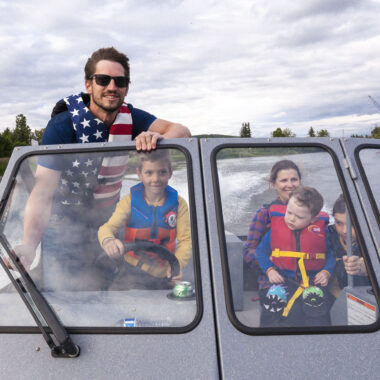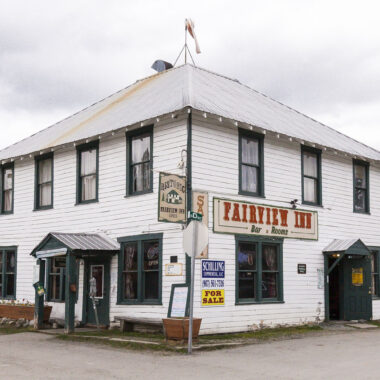Our first view of Denali came from more than 50 miles away as we were traveling south on the Parks Highway near Nenana from Fairbanks. Even though Denali is nowhere near as high as many of planet’s other peaks – at 20310 feet/6190 meters tall – its low base puts it third in a ranking of the globe’s most prominent and most isolated peaks (after Mount Everest and Aconcagua). As we were driving it poked above the horizon like a pimple covered in snow and ice, nothing but black spruce-covered permafrost visible anywhere else from our windows. On a clear day its peak is visible from Anchorage, which is more than 130 miles/210 kilometers away.
Get Directions
As one of the most famous national parks in the country, travelers migrate to Denali National Park from all over the country each summer. COVID was no exception: it was the first time we’d needed to book a campsite anywhere since leaving Bellingham almost a month ago (but even then, we only had to book the night before, gotta love Alaska…). Riley Creek Campground was full for both our nights in the park, but it was a very well spaced layout and we thoroughly enjoyed the spots where we camped amongst the spruce.
Denali National Park is a behemoth piece of land, covering a whopping 6.1 million acres. The single road that traverses the park from east to west is 92 miles/148 kilometers long! When it comes to national parks, Denali has a couple of unique traits: you cannot drive into the park in your own vehicle (unless you win a coveted spot in the annual September lottery) and the place is for the most part completely devoid of any permanent hiking trails. The national parks service runs a couple of bus systems that allow visitors to traverse the park’s road, but the buses book out quickly, even during COVID. Upon arrival at Riley Creek on Wednesday I was able to secure walk-up spots for the four of us on the next day’s 7:30AM bus (whew, sigh of relief…), and we spent the rest of the afternoon exploring some of the small number of permanent trails around the Savage River area (which is the furthest one can drive into the park on the road).
No views of Denali from Savage River, but the views of the Alaska Range from the Savage River Alpine Trail were incredible. We saw our first caribou strolling along Savage River as we were walking along the banks, and also a cute little rock ptarmigan and her chicks running about in the bushes. Such breathtaking scenery everywhere we looked.
It was up and at ’em early for our 7:30AM bus departure, we also had to swap campsites on our full day in the park, so had to take the trailer to the bus parking lot for the day. We were like a well-oiled machine getting the trailer packed up and hitched within 15 minutes of our alarms. There are two types of buses that traverse the parks: transit buses and tour buses. Both use repurposed school buses for the routes, the only difference being that the tour buses have a dedicated guide and provide guests with a snack pack for the journey (and cost more that 3X as much!). The transit bus drivers, however, are generally very chatty and provided us with an excellent narrative of the park as we drove, always on the look out for the plethora of wildlife that call Denali home. It’s a long day on the bus: the route to Eielson Visitor Center at Mile 66 takes more than eight hours. That said, with the breathtaking scenery and views of Denali along the way, it really didn’t feel like it took four hours to make it to the turnaround point.
The buses stop roughly every 60-90 minutes for restroom breaks and to allow everyone to stretch their legs. I think my favorite stop along the way was at Polychrome, a gigantic valley with amazing views of the Alaska Range and its glaciers, the lower mountains a myriad of colors from the different types of rocks present in the soil. It was around the Polychrome area of the park where we started to spot wildlife at almost every turn: moose, caribou, grizzlies, golden eagles… So much excitement from the kids every time another animal was spotted, and I must say that Lisa without a doubt had the best eyes on the bus for spotting wildlife. The reason the park doesn’t allow personal traffic was quite evident as we motored west out of Polychrome, the one lane gravel road traversed a section of sheer cliffs for a number of miles, Lisa and Lilia couldn’t look down!
As we neared the turnaround at Eielson, there was a grassy valley between the Stony Hill Overlook and Thorofare Pass where we spotted quite a few grizzlies. There are no salmon runs in Denali so the bears subsist mainly on vegetation – grasses and berries – and are therefore significantly smaller than the coastal browns we saw in Sitka. Jeff, our bus driver, estimated the bears we saw to be around 400 pounds/180 kilograms, babies compared to the 1500 pound/680 kilogram monsters we saw in Southeast Alaska. Nonetheless, bear sightings always generated a lot of excitement in the bus, and we spent a lot of time in the valley before Eielson watching a couple of cubs run around after their mother and enjoy some of the last remaining snow patches from winter.
As has been the case pretty much everywhere except our week in Juneau, we were incredibly lucky with the weather for our time in Denali. July is the wettest month of the year in Denali National Park and the mountain is only visible one out of every three or four days due to weather. At Eielson we were not only able to see the mountain in all its splendor, but were able to do so with clear blue skies and some of the warmest weather of the year. The size of the mountain – and everything else in Denali – was incredible. It was also quite cool to see the surging Muldrow Glacier grinding its path down from the mountain more than 100 times faster than the glacier typically moves (it’s the snaking mass of ice and dirt you can see in the valley underneath the mountain in the photos below). Thousands of climbers attempt to summit North America’s tallest peak every year, there were 186 of them on the mountain when we visited, roughly 50% of them are typically successful. Kudos to Lilia for the shot of Mum and Dad below, a photographer in the making!
We stayed at Eielson to explore some of the small handful of trails around the visitor center and take in the views. With the transit buses, one is allowed to switch buses during the day but that comes with the gamble their will be a spot on a subsequent bus to take you back out of the park. With only a single bus every hour one can end up waiting for quite some time! Fortunately there was room for the four of us on the bus an hour after we hopped off our original one, all of us except Lisa nodding off here and there after the early morning wake up (I know, it wasn’t that early, but with constant daylight up here it takes some work for everyone to get to sleep each night…). More caribou and bears on the way back out of the park, a mother and her year old cub walking right alongside the bus was a memorable part of the return journey.
With the bus change, it was over nine hours from start to finish. With the brilliant weather and resulting views, coupled with all the wildlife, it didn’t feel that long. But I can see why the park service warns parents against taking small children through the park. Even though there are very few permanent trails in the park, unlike most of the United States’ national parks Denali allows wilderness hiking almost everywhere in the park’s 6.1 million acres. If it was just Lisa and I, I think we would have hopped off to explore some of the park on foot – maybe around Polychrome or one of the other rivers – but with the littles I think it would have absolutely wiped them out if we’d hiked more than we did around the Eielson Visitor Center. An amazing day and very memorable experience for all of us. Max’s count on all the animals:
- One golden eagle
- One moose
- Two rock ptarmigans (and a handful of chicks)
- 11 caribou
- 12 grizzlies
- 16 Dall Sheep
Denali National Park Tips
As I mentioned, Denali is a little unique with the buses and lack of hiking trails. We were lucky to visit during COVID when the visitor load was reduced, but I can see this place being an absolute zoo in a normal summer season. A few things we learned along the way if you ever find yourself visiting…
- The tour buses are really not worth it over the transit buses. The tour buses use the same physical buses, but just add a narrator and snack box for more than 3X the price. The transit bus drivers we had provided and excellent narration of the park, and the transit buses allow you to hop on and off as you traverse the park.
- If you cannot secure a spot on a bus before arriving to Denali don’t despair: walk-up tickets can be booked at the Denali bus depot (near Riley Creek Campground) the day before starting at 11AM.
- If your kids have lots of energy, Denali may not be for you. The only way to see the mountain in all its splendor is to sit through a minimum eight hour bus trip there and back. Wonder Lake, which is past Eielson, dictates even longer on the bus.
- Don’t worry if you can’t get a seat on an early morning bus. The light is best for photos of the mountains in the morning, but it’s light for almost 24 hours a day in summer so even evening buses allow great views (assuming the weather cooperates).
- If you’re in a camper or RV, Riley Creek Campground is the place to be. The other campgrounds in the park are angled towards tents and most of them need to be accessed by the camper bus system.































































Pingback: Talkeetna and Surrounds
You guys are seeing beautiful landscapes and wildlife including GREAT weather. How are you returning home from Alaska? Ferry from Skagway or driving thru Canada?
Sprinting through Canada on the Alaska Highway, Alan!
Stunning mountains AND photos!!!!!!!!!!!!!! 💖🤗💖
Well done team Valtenbergs!! The weather Gods have certainly been watching over you.